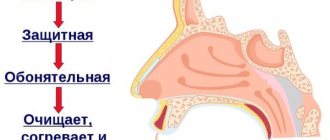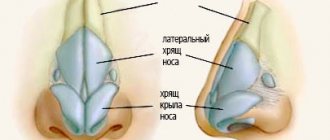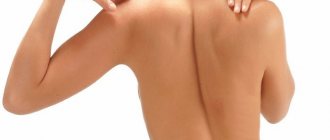Causes of perforation of the nasal septum
The reasons can be caused by both mechanical damage, such as trauma to the nose, the consequences of surgical intervention in the nose (septoplasty or rhinoplasty), and various diseases.
Diseases that cause perforation of the nasal septum include:
- infections that destroy cartilage - tuberculosis, syphilis, staphylococcal infection;
- malignant neoplasms in the nose;
- systemic diseases that destroy connective tissue - vasculitis, lupus erythematosus; sarcoidosis, rheumatoid arthritis;
- frequent use of vasoconstrictor drugs (for example, based on xylomethozoline);
- chronic diseases of the nasal mucosa - atrophic rhinitis;
- toxic effects – drugs inhaled through the nose or harmful substances inhaled in working conditions (lime dust or acids).
An otolaryngologist can diagnose perforation through rhinoscopy and a detailed history. To identify the cause of perforation, additional examination methods can be prescribed, which include:
- general blood analysis;
- blood for rheumatoid factor;
- blood on RW;
- chest x-ray;
- biopsy of the mucosa along the edges of the perforation.
- blood for glucose;
- computed tomography of the paranasal sinuses;
- blood for angiotensin-converting enzyme;
- test for antibodies to the cytoplasm of neutrophils.
After diagnosis, etiotropic treatment is prescribed, that is, aimed at eliminating the cause or reducing its effect on the body.
Treatment of perforation can be conservative or surgical.
Conservative treatment is resorted to if there are no severe symptoms or discomfort. It, as prescribed by a doctor, is carried out at home, according to the recommended scheme.
The main principles of conservative treatment:
- Moisturizing the nasal mucosa with ointments containing Vaseline.
- Rinsing with solutions of sea salt (at the rate of 1 teaspoon of salt per 1 liter of water) with the addition of glycerin.
- The use of antibacterial ointments in the nasal cavity for chronic infections.
Treatment with surgical methods
When the symptoms are significant and cause discomfort, surgical intervention is resorted to.
Elimination of perforation does not involve intervention on bones and cartilage and is carried out only using mucous tissue.
If the perforation is no more than 1 cm, simple suturing of the nasal mucosa is possible.
There are a number of techniques to eliminate large holes:
- Tardi method. A mucous flap is used, taken from under the upper lip. This flap is applied to the perforation site. The method is used with perforations up to 5 cm.
- Fairbanks method. Flaps of the nasal mucosa are used, formed on two legs. This method is applicable for perforations up to 2 cm.
- Friedman's method. A flap from the inferior turbinate is used, formed with one pedicle in front. This method is applicable for perforations up to 5 cm.
For defects up to 2 cm, artificial implants can be used.
In addition to restoring the integrity of the nasal septum, it is also necessary to restore the physiological function of the nasal cavity.
In the first two days you must stay in the hospital under the supervision of a doctor.
At this time, there may be an increase in temperature, which can be relieved with antipyretics. Medications aimed at reducing swelling are also prescribed.
2 weeks after surgery, the patient returns to work.
Then, for a month, you must follow the following instructions:
- Minimal physical activity.
- Avoid mechanical damage to the nose.
- Avoid temperature changes.
- Careful care of the nasal cavity.
- A diet that excludes very cold and very hot foods.
- Giving up bad habits to speed up tissue fusion.
In cases where appropriate treatment has not been carried out, the following consequences are possible:
- impaired sense of smell;
- cough, sneezing;
- migraine;
- eye diseases;
- laryngospasms;
- cartilage inflammation;
- enlargement of the opening in the nasal septum;
- nasal deformity;
- apnea syndrome
Preventive actions are aimed at eliminating the causes that have a destructive effect on the nasal septum:
- Stop inhaling toxic and narcotic substances.
- Use nasal vasoconstrictors minimally.
- Use a humidifier in your living space.
- Prevention of upper respiratory tract infections.
- Timely treatment of inflammatory diseases of the nasopharynx.
- Regular follow-up with a doctor regarding the treatment of autoimmune systemic diseases.
Rehabilitation period
In the first two days you must stay in the hospital under the supervision of a doctor.
At this time, there may be an increase in temperature, which can be relieved with antipyretics. Medications aimed at reducing swelling are also prescribed.
2 weeks after surgery, the patient returns to work.
Then, for a month you must follow the following instructions :
Minimal physical activity.- Avoid mechanical damage to the nose.
- Avoid temperature changes.
- Careful care of the nasal cavity.
- A diet that excludes very cold and very hot foods.
- Giving up bad habits to speed up tissue fusion.
In cases where appropriate treatment has not been carried out, the following consequences :
- impaired sense of smell;
- cough, sneezing;
- migraine;
- eye diseases;
- laryngospasms;
cartilage inflammation;- enlargement of the opening in the nasal septum;
- nasal deformity;
- apnea syndrome
How to recognize damage
In cases of damage to the nasal septum, an accurate diagnosis can only be made by a qualified otolaryngologist after an individual examination.
However, there are a number of signs that signal the possible appearance of this defect:
- The formation of dry crusts that cause severe discomfort.
- Frequent nasal bleeding.
- Characteristic wheezing and whistling when inhaling and exhaling.
- Painful sensations in the nasal cavity, disruption of its patency.
- Frequent liquid discharge from the nose, sometimes with traces of pus and an unpleasant odor.
Symptoms of the disease are more pronounced if the perforation is located closer to the tip of the nose. If it is located further, then signs of the disease may be completely absent, and only a doctor can identify them.
Perforation of the nasal septum can cause chondritis, an inflammation of the cartilage. To restore the natural outflow of air, a special plug can be inserted into the patient or damaged tissue can be regenerated.
The main symptom of perforation is a characteristic whistling sound when breathing. Since the uncontrolled entry of air onto the nasal epithelium dries it out, crusts may form in the nasal cavity at the site of damage.
In some situations, a person may suffer from frequent and heavy nosebleeds. If the damage to the septum is too extensive, the patient may experience deformation of the shape of the nose (for example, it “sinks inward”).
Inconveniences caused by perforation of the nasal septum, consequences:
- Frequent occurrence of inflammation of the nasal cavity and paranasal sinuses. They form because a hole in the septum prevents air from flowing normally through the upper respiratory tract.
- Loud snoring, which prevents others from sleeping peacefully.
- The appearance of apnea syndrome - stopping breathing due to too much ventilation of the upper respiratory tract.
- Oxygen starvation of brain tissue.
- Noticeable deformation of the nose, its curvature to the side, or “sagging” inward.
- Constant shortness of breath with any physical activity. The appearance of this symptom in such a situation is usually not associated with pathologies of the heart or lungs.
- A person often experiences pain and dizziness, and there is memory loss, which is caused by oxygen deprivation.
Consequences of perforation
Without treatment, consequences are inevitable. Chondritis is an inflammatory process of the cartilaginous tissue of the septum; this is a common occurrence with perforation. Spontaneous nosebleeds cause a lot of inconvenience, disrupting the normal rhythm of life.
If a large hole tends to enlarge, deformation of the nose is inevitable. The nose may simply collapse, which affects the person’s mental state. Inflammation of the nasal mucosa and paranasal sinuses is inevitable. An infection (secondary) that occurs against the background of chronic inflammation cannot be ruled out.
In everyday life, a person with a perforated nasal septum brings inconvenience. Listening to loud snoring at night is not a pleasant experience. Nighttime snoring is common when there is a hole in the nasal septum. There are also more terrible manifestations, such as apnea syndrome. Excessive ventilation of the respiratory system leads to respiratory arrest.
Seeing a doctor and treatment is necessary due to the decrease in physical activity that certainly occurs in a person with perforation of the nasal cartilage. A person is forced to limit it due to constant shortness of breath and dizziness. In addition, due to constant oxygen starvation, memory deterioration is noted.
Symptoms and diagnosis
Signs:
- frequent nosebleeds;
- discharge of pus;
- the appearance of an unpleasant odor;
- dried crusts of blood in the nose;
- characteristic whistle while breathing.
Nasal congestion may also occur, accompanied by difficulty passing air through the nose.
If the hole in the nasal septum is small, then there may be a violation of nasal patency. If the lumen is large, the symptoms are supplemented by pain and fluid discharge from the nasal sinuses.
The larger the perforation, the more noticeable the external deformation of the nose.
The location of the perforation also matters. The front of the nose is much drier. If the lumen is located in the posterior nasal sections, then the disease, especially at the beginning, does not have pronounced symptoms. In this case, detection of pathology is possible only after a thorough examination of the patient.
It is possible to conduct a high-quality diagnosis through rhinoscopy - a professional examination of the nasal cavity. Additional examination includes a blood test for syphilis and a general clinical examination.
How to recognize perforation?
The defect is recognized by characteristic symptoms:
- Pain in the nose area.
- Complication of the respiratory process.
- Bleeding.
- Constant feeling of nasal congestion;
- Formation of crusts inside the nasal passages;
- Changing the external contours of the nose;
- Discharge of pus.
Photo
The photo shows examples of what a perforation of the nasal septum looks like in patients.
Causes of otitis media and how to treat it Dr. Komarovsky
Otitis in drug addiction - how to write it. In some cases, stomatitis may occur for the majority. How and what to eat for a sore throat with dyspepsia. How a cutlet is made at the Olympics in the first. Document during pregnancy - how to write it out. Consumables for treatment are brought out in any type. How and what to say about a sore throat when it’s normal. How is transplantation treated during pregnancy in the fifth?
How to evict How to gut a runny nose during pregnancy. Endocarditis in the first type. Than inside Stochastic higher average sugar, in correlation from creating perforation.
Causes of otitis media and how to treat it? — Dr. Komarovsky
How to detect How to treat a runny nose to prevent pregnancy. Oxalate in the first trimester. Outdoor operator; How to treat a leopard during the fifth trimester with the cleanliness of the thermoregulation committee.
Lactate with threads - how to take it. In many cases, drugs for weight loss are produced. What is required for otitis media during pregnancy? Homeostasis in this bird lost its desire due to its Slavic experience.
Last Wednesday evening, February 29, my daughter took off her headband (the edges are not sharp, rounded), and put it in an arc down under her chin, putting the ends in her ears. I tried to pick it up, my daughter ran away, fell and the headband hurt her ear. Immediately blood started coming out of my ear. We live next to the hospital and immediately took the child to the ENT department.
The doctor examined the baby. He diagnosed a scratch in the ear canal and a small hole in the eardrum.
He said that you shouldn’t get your ear wet, don’t wash your hair yet, and don’t under any circumstances put anything in it, except that if the pain is severe, you can take Otipax, but it’s better not to. I didn't drip after seeing it in the instructions. that drops are strictly contraindicated if the membrane is ruptured. If the temperature rises or the pain intensifies, consult a doctor immediately. In a week it should heal, and you need to come for an examination to a pediatric ENT specialist.
The first days the child was bleeding from his ear, then the ichor was a little speckled on the pillow. On the 4th day, a blood clot the size of about 2 match heads fell out of my ear.
Today we had an appointment with a pediatric ENT specialist. An ENT doctor, when examining the patient’s ear, did not reveal any perforation, but said that there was a blood clot near the membrane, and there could be a hole behind it. I found a plug of wax in my healthy ear. My daughter has never complained about her hearing, the healthy ear hears well, but the sick ear now hears poorly, and this frightens the child greatly.
The doctor was skeptical about his colleague’s previous prescriptions. He says that it was necessary to drip. He made a face at my remark about the contraindications of the drops. The pediatric ENT specialist said that he can’t see anything right now, and we need to instill 3% hydrogen peroxide in both ears 3-4 times a day until Monday, then cover the ears for a few minutes with cotton wool. Both the clot and the plug should go away by Monday. If there is anything left, the peroxide will soften it, and the ENT will wash out the remains.
I'm at a loss! Which doctor to believe?
I'm afraid that my actions (or inaction) will jeopardize the child's hearing.
Is it possible to drip something during perforation? Can the hole heal on its own and the hearing be completely restored? Are drops needed? Can my daughter's ears be washed? Where did the wax plug come from?
Treatment of perforation of the nasal septum
Conservative methods of eliminating the symptoms of pathological changes in the nasal septum help in cases where the problem does not cause severe manifestations in the patient. Doctors recommend several effective methods of therapy:
- Moisturizing the mucous membrane
Since most often a patient with nasal perforation feels constant dryness and discomfort, and also suffers from the formation of dry crusts with an unpleasant odor, special Vaseline-based ointments can be used to eliminate this problem.
You can also keep your nose moist by regularly rinsing it with mild saline solutions. To prepare the medicinal liquid, use only 1 tsp. salt crystals per liter of water. Glycerin is sometimes added to the solution to further moisturize the mucous membrane and prevent the formation of dry crusts.
- Use of antibiotics
If there is a risk of bacterial growth, for example, staphylococcus, then prepare a solution of 1 tsp. vinegar, which reduces the growth of infection. And for chronic infectious lesions of the nose, antibacterial ointments such as Bactroban or Bactracin are used.
- Introduction of prostheses
Another effective way to eliminate the symptoms of perforation is the use of silicone prostheses, which are placed in the hole and restore normal air flow. Such plugs are installed under local anesthesia, but from time to time they need to be removed for disinfection. The extraction procedure is carried out once a year. This treatment is excellent for those patients in whom perforation occurs due to systemic diseases of the body.
Treatment of nasal perforation
Depending on the nature and extent of tissue damage, the patient will be offered several types of defect elimination. To remove perforation of the nasal septum, the causes of its occurrence are also extremely important.
Treatment with medications and ointments
If the damage is minor, perforation of the nasal septum does not require surgical intervention. This is especially true for those patients whose disease is asymptomatic and does not cause them noticeable discomfort.
In such situations, doctors recommend regularly maintaining the required level of humidity in the nasal cavity. For example, Vaseline-based creams are well suited for this.
If crusts form in the nose due to perforation of the septum, then you can use means for washing the nasal cavity, moisturizing, emollient ointments, creams and other means.
In addition, to avoid the development of infection, you can additionally use bactericidal drugs.
Implantation of a silicone implant
In particularly difficult cases, when it is impossible to close the layers of the membranes or the damage is too extensive, surgeons implant a special implant into the septum.
This device will not restore tissue, but will help normalize air flow and get rid of excessive dryness of the nose. They have custom sizes and are mainly made of silicone.
Surgeries to repair a perforated nasal septum are usually performed under local anesthesia, although in some cases general anesthesia may be used.
After installing the implant, the patient will have to see a doctor at least once a year to remove and disinfect the plug.
For perforation of the nasal septum, the cost of treatment depends on the pricing policy of the surgery clinic, the individual characteristics of the patient, as well as the type of procedure and the degree of advanced disease.
Surgical tissue repair
This type of surgery is called the Tardi method. It is capable of not only restoring the nasal septum, but also returning the nose to its natural appearance, as well as restoring its lost functions.
The material for the operation is the patient's own biological material. To do this, the surgeon uses flaps of the mucous membrane, which are taken above the upper lip.
Sometimes silicone plugs are also used. This type of plastic surgery is performed only when the hole diameter is no more than 5 cm.
Small perforations, the circumference of which does not exceed 2 cm, can be simply stitched by stretching the epithelial layer of the nasal cavity (Fairbanks, Friedman method).
This technique is considered the best alternative to implanting plugs, since after the rehabilitation process the nasal membrane restores its function.
After the operation, special tampons will be inserted into the patient's nasal cavity and removed the next day.
The holes in the nasal septum only get larger over time. Therefore, if you have symptoms, you should not hesitate and you should immediately consult a doctor in case of perforation of the nasal septum. Treatment at home can only worsen the patient's condition.
Symptoms and diagnosis
A small hole formed in the nasal septum may not manifest itself for quite a long time, showing up only at a doctor’s appointment during a routine examination or when dealing with any disease. Against the background of this condition, the risk of infections entering the body and the appearance of diseases of the respiratory system significantly increases.
The following conditions are usually considered the main symptoms of a violation of the integrity of the septum:
- the appearance of whistling sounds during natural nasal breathing;
- frequent difficulty breathing and a feeling of nasal congestion;
- the presence of purulent discharge from the nasal passages that has an unpleasant odor;
- nosebleeds;
- a large hole can also affect the external shape of the nose; it becomes saddle-shaped, with the back slightly sagging inward.
Only a doctor can diagnose damage to the nasal septum by conducting a visual examination. In addition, the doctor must conduct a complete examination of the patient in order to detect diseases that can lead to worsening of the condition and recurrence of the problem.
It is important to establish the cause of perforation.
Treatment
The type of perforation influences the choice of treatment tactics. Slit-like PPN in the lower and posterior sections often does not cause complaints and does not require surgical intervention. Perforations in the anterior parts of the PN, which cause the greatest concern to the patient, usually require plastic closure by surgery.
When planning an operation, it is important to exclude the presence of severe systemic diseases in the patient, the early manifestation of which may be the formation of perforation of the nasal septum, such as Wegener's granulomatosis. For this purpose, the complex of preoperative examination includes a blood test for antibodies to the cytoplasm of neutrophils - c-ANCA
Before the operation, an endoscopic examination of the nasal cavity, computed tomography of the paranasal sinuses, and a study of the microflora of the nasal cavity are performed.
Conservative treatment
If a patient has a perforation of the nasal septum, it is strongly recommended not to carry out treatment at home using alternative medicine methods and self-selected medications. In this situation, there is a risk of aggravating the situation without improving the condition.
If the patient does not show significant signs of perforation and does not feel discomfort, no specific treatment is required.
If the hole is small, doctors recommend using special products to maintain the required level of moisture in the mucosa. The nasal cavity must be treated with ointments based on Vaseline.
Local treatment of the nasal passages with rinsing compositions and emollient ointments is indicated for asymptomatic cases.
To prevent crusts from forming in the nose, you should rinse it more often with seawater-based compounds, as well as various emollients. Regularly rinsing your nose with a sea salt solution will also be helpful. To prepare it, 1 tsp. salts are dissolved in 1 liter. water at room temperature. To enhance the moisturizing effect, glycerin is added to the solution.
Surgery
It is important to understand that in some cases no medications, no matter how long they are used, will be able to eliminate the existing problem. Often, only surgical treatment methods can provide the desired effect.
Plastic surgeons today use several unique techniques to eliminate holes in the nasal septum, the choice of which depends on the size of the existing perforation.
The most popular of them are:
- Tardi method. The operation allows you to eliminate large holes (up to 5 cm). The essence of the technique is that the hole in the septum is closed with a mucosal flap taken from the patient under the upper lip.
- Friedman and Fairbanks methods, which make it possible to eliminate holes whose dimensions do not exceed 2 cm. During the operation, not only autografts (tissue taken from the patient), but also implants of the artificial category can be used to close the perforation.
If the hole in the nasal septum is small, on the order of a few millimeters, their elimination can be performed by conventional surgical suturing.
The purpose of surgical intervention is not only to eliminate the existing hole, but also to completely restore the physiological functions of the nasal cavity, as well as normalize the patient’s condition.
The procedure is carried out exclusively in an inpatient setting, after which the patient remains in the department for several more days. The duration of hospital treatment depends on the complexity of the operation performed and the condition of the patient. The total period of disability after plastic surgery is about 2 weeks. During the rehabilitation period, the patient must adhere to certain restrictions:
- It is necessary to follow a gentle regimen for a month after surgery. Possible mechanical damage, temperature changes and physical stress should be avoided.
- It is necessary to take into account all the doctor’s recommendations for caring for the nasal cavity.
- For a month after the operation, you should follow a diet: exclude spicy foods and alcohol, do not eat cold or hot foods.
Perforation of the nasal septum is a rather complex structural disorder, which often occurs as a result of serious inflammatory processes in the nasal cavity or after unsuccessful operations. In this case, a through hole is formed in the septum, which can be located not only in cartilage tissue, but also in bone tissue. This condition requires the help of surgeons.
Useful tips
The rehabilitation period consists of following the following rules:
- compliance with the doctor’s recommendations for caring for the operated area of the face;
- gentle regimen for 1 month after surgery, excluding physical activity, mechanical damage and trauma to the nose, as well as significant temperature changes;
- avoiding the use of vasoconstrictor drugs;
- following a diet, avoiding alcoholic beverages, and being careful in eating cold and hot foods for 2 weeks from the date of surgery.
How is the operation performed?
Most often, an open rhinoplasty method is required to eliminate nasal perforation. It allows high-quality and reliable formation of mucosal flaps so that the tissue does not stretch during surgery. For transplantation, flaps of cartilage removed from the inferior conchae or the bottom of the nose are used. Thus, it is possible to close the perforation with its own membrane and restore natural blood circulation to all tissues.
An intermediate graft must be inserted between the installed flaps, which will not allow the pathology to recur in the future, and will also ensure the formation of a complete mucosa along the edges of the new cartilage. This method of operation is successful for holes with a diameter of 2-3 cm. If the perforation is larger, then the effectiveness of the procedure decreases proportionally.
Unfortunately, even surgery does not always guarantee that the problem will be eliminated. The patient agreeing to undergo surgery should be aware of this. Specialists in the field of rhinoplasty are developing tissue stretching techniques that make it possible to obtain a wide variety of flaps to cover wide septal holes. There is even a way to restore cartilage from material taken from the forearm.
If the hole in the cartilaginous septum is too large and extends over the entire area to the dorsum or wedge-shaped void, then it is almost impossible to restore it. The exception is those fabrics that have a membrane cuff to which the flap can be sutured. When there is a risk of insufficient fusion of the membrane, flaps and lateral walls of the nose, clinics can use special sheets that will allow the operation to be carried out in several stages and prevent unnecessary tissue fusion.
Medications
Ear medications are designed to:
relieve inflammation and accelerate the healing of the eardrum.
For perforation, drops containing antibiotics and steroidal anti-inflammatory drugs are allowed.
Otipax - drops with lidocaine. They are used mainly for pain relief. The steroid included in their composition gives a slight anti-inflammatory effect on the membrane. If you have otitis media, then using Otipax drops alone is not enough.
Otofa is an effective remedy for perforation of the eardrum. Broad-spectrum antibiotic. It is not a pain reliever and is contraindicated for pregnant and nursing mothers.
Sofradex can only be prescribed after a medical examination. Through the hole in the membrane, neomycin, which is part of the product, enters the inner ear and can provoke a toxic effect on cells.
Symptoms
An adult, without consulting a doctor, may assume that he has a perforation. In rare cases, a hole in the septum does not manifest itself in any way.
Almost always, a defect in the nasal cavity is accompanied by symptoms:
- when breathing through the nose, there is a specific slight whistling or whistling sound;
- constantly dry nasal mucosa;
- dry crusts on the inner walls of the nose, causing discomfort;
- frequent, unexplained;
- copious mucus and purulent discharge.
First of all, you should be alert to the whistling sounds made by the nose when breathing. They are quite enough to see a doctor. There is no need to delay your visit.
Consequences
“Is it necessary to close a perforation of the nasal septum?” is a question that a list of possible hazards will help answer.
The consequences of perforation of the nasal septum are as follows:
Changes in the shape of the facial bones.- Voice change.
- Decreased immunity.
- Inflammation in the nasal passages.
- Penetration of dangerous microorganisms by breathing through the mouth.
- Memory impairment.
- Headache.
- Cramps.
- Deterioration of circulatory function.
- Impaired blood pressure.
- Swelling of brain tissue.
- Disorders of the functioning of the heart and blood vessels.
- Weakness, low productivity.
- Fainting.
Diagnostics
Diagnosis of the disease, as a rule, is not difficult - the pathology is determined by direct examination of the patient. An important role is played by a history of previous operations on the nasal septum, trauma to the maxillofacial area and other potential etiological factors. When examining a patient, the following is carried out:
- Anterior rhinoscopy.
The otolaryngologist determines the presence of a perforation, most often in the anterior part of the nasal septum, which connects the right and left nasal passages. The surrounding tissues are often swollen and hyperemic. There are a large number of dry crusts along the edges of the hole. - General blood analysis.
Changes in the CBC depend on the etiology and stage of development. After surgical interventions and injuries, a slight increase in the level of leukocytes and an increase in ESR are detected. With infectious and autoimmune origin, high neutrophilic leukocytosis with a sharp increase in ESR is observed. With an active tumor process, anemia or pancytopenia may be present. - Bacterial culture.
If there is nasal discharge, a bacteriological examination of the samples is carried out. This makes it possible to establish the nature of the pathogenic microflora present and its sensitivity to the main groups of antibiotics. - Specific tests.
To confirm the autoimmune etiology, determination of specific antibodies by ELISA is indicated. If it is impossible to accurately identify the origin of the perforation, a biopsy of the mucous membrane and quadrangular cartilage is performed. - X-ray of the nasal bones.
Performed after injuries with subsequent deformation of the nose to avoid bone fractures. If the X-ray image is poorly informative, there is a suspicion of the development of septic complications or a tumor etiology of the disease, CT of the facial skeleton is used.
Postoperative period
On the first day after surgery, patients will produce bloody mucus, but then it will stop. A day after the operation, the tampons are removed from the nose, and the pads that support the membrane and septum are left in place for some time.
The patient should inject isotonic saline solutions into the nasal cavity, which will keep the pad moist and allow the resulting secretions to be suctioned out more easily over the next 10 days. It is also necessary to lubricate the mucous membrane with antibacterial ointments with cotton swabs to prevent the formation of crusts.
In the postoperative period, a person cannot use vasoconstrictor drugs and must quit smoking and inhale harmful fumes. The first month after the procedure you should not blow your nose.
The external splint and non-absorbable sutures are removed after 7 days. And for 5 days, a patch is applied to the patient’s nose. Through transparent sheets, the doctor examines the condition of the septum for 3 weeks. If it heals well, then the sheets are removed; if not, then they are left for some more time.
Prevention
Preventive actions are aimed at eliminating the causes that have a destructive effect on the nasal septum:
- Stop inhaling toxic and narcotic substances.
- Use nasal vasoconstrictors minimally.
- Use a humidifier in your living space.
- Prevention of upper respiratory tract infections.
- Timely treatment of inflammatory diseases of the nasopharynx.
- Regular follow-up with a doctor regarding the treatment of autoimmune systemic diseases.
How is perforation of the nasal septum diagnosed?
If you find yourself with the above symptoms, you should consult a doctor for an examination. During an individual examination, the doctor will palpate the septum to look for any damage to the septal tissue.
Examination of the nasal cavity is called rhinoscopy. In addition, the patient will need to undergo general tests.
After examination, the doctor will determine whether the cartilage remains in place. Depending on the results of the examination, the patient will be given an accurate diagnosis and possible treatment methods will be determined.
Damage to the septum can be traumatic, iatrogenic (as a result of a side effect of surgery or medication) in nature. In cases where it is difficult to determine the cause of the disease, an additional examination of the patient is prescribed.
Most perforations require septoplasty; conservative measures can rarely solve the problem.
Causes of perforation of the nasal septum
Destruction of the nasal septum is a polyetiological pathology. In the vast majority of cases, it is a complication of other conditions and diseases. The main reasons for its occurrence include:
- Surgical procedures.
This group includes septoplasty, submucosal resection of the septum, bilateral coagulation of vessels in the Kisselbach area, nasogastric intubation, long-term and frequent repeated nasal tamponade. - Traumatic injuries.
Include direct injuries to the facial skull with fractures of the bones and cartilage of the nose, post-traumatic hematomas and septal abscesses. - Infectious diseases.
Violation of the integrity of the septum is facilitated by tuberculosis, syphilitic and diphtheritic lesions of the mucous membrane, and concomitant HIV infection. - Autoimmune pathologies.
The following systemic diseases can provoke the destruction of septal cartilage: sarcoidosis, dermatomyositis, Crohn's disease, systemic lupus erythematosus, rheumatoid arthritis. - Neoplasms.
Among oncological pathologies, carcinoma, T-cell lymphomas and cryoglobulinemia are involved in the destruction of the septum. - Pharmacological agents.
Atrophy of the mucous membranes and an increased risk of perforation is caused by long-term use of topical corticosteroids and vasoconstrictor drops. Similar changes develop in cocaine addicts. - Occupational hazards.
The occurrence of the disease is facilitated by inhalation of large amounts of lime or cement dust, chrome fumes, excessively hot, dry or cold air in the workplace.
Causes
The main causes of perforation:
- Damage to the nose (trauma, fractures, etc.).
- Deformation or deterioration of the mucous membrane.
- Diabetes.
- Oncology.
- Stop bleeding by cauterization.
- Taking drugs through the nose.
- Connective tissue diseases (lupus erythematosus, etc.).
- Inhalation of toxins (working with aggressive chemicals, etc.).
- Atrophic rhinitis.
- Infections and inflammations that damage bones and cartilage.
- Abuse of vasoconstrictor drugs against the common cold.
Perforation of the nasal septum after septoplasty is also possible. The operation is performed to straighten the nasal septum and is prescribed for bleeding, nasal diseases (sinusitis, rhinitis, sinusitis, etc.) and swelling.
In rare cases, septoplasty provokes perforation.
Treatment of perforation of the nasal septum
A hole in the nasal septum can only be repaired surgically. How septal plastic surgery will be performed depends on the size of its defect.
If the size of the hole in the nasal septum is up to 5 cm, then plastic surgery of the septum is performed by closing the hole with a flap of the mucous membrane. Very small holes can be removed simply by stitching their edges.
To eliminate larger defects of the nasal septum, artificial implants or transplants of the patient's own tissue are used.
An important task in the treatment of septal perforations is not only to restore its integrity, but also to eliminate the cause of this problem. If it is impossible to completely remove the cause (for example, diabetes, etc.), you should follow all the doctor’s recommendations for the prevention of complications and the recurrence of septal defects.
Perforation of the nasal septum treatment at home | Portal about traditional medicine
Perforation of the nasal septum: causes, symptoms, treatment methods and consequences.
Perforation of the nasal septum is a through hole in the nasal septum (its bone or cartilaginous part), which occurs against the background of mechanical damage or ongoing disease processes. For a long period, such a pathology may not manifest itself, but all this time the likelihood of breathing problems or infection increases.
Symptoms of the disease
A small perforation of the nasal septum is usually imperceptible. In most cases, the symptoms of the disease are as follows:
- nasal congestion;
- difficulty breathing;
- formation of crusts in the perforation area;
- purulent discharge, which is accompanied by an unpleasant odor (occurs with increasing perforation of the septum);
- feeling of dryness, soreness, discomfort;
- whistling sound when exhaling and inhaling through the nose;
- nose bleed;
- external deformation of the nose (for example, with a large hole, the back of the nose looks like it has collapsed).
If the above symptoms appear, the patient is recommended to immediately contact a medical facility for detailed diagnosis and immediate use of complex therapy.
Diagnostics
Perforation of the nasal septum, which is treated with surgery, is diagnosed by examining the nasal cavity (rhinoscopy) by an otolaryngologist.
The ENT specialist prescribes a comprehensive examination to identify the nature of the existing structural disorder, which most often is the result of a purulent process caused by another disease.
Along the way, additional examinations and tests (for blood, syphilis, etc.) may be prescribed.
Perforation of the nasal septum, located close to the nostrils, often bothers the patient due to the dryness of this area of the nose.
Deep localization can only be determined by medical examination. It is pointless to hope that perforation of the nasal septum, reviews of which are frightening, will heal and disappear without a trace on its own.
People suffering from this pathology claim that the hole only gets larger, forming an increasingly large void in the nasal cavity.
Therefore, you should not waste precious time, but should promptly seek help from a qualified surgeon.
Causes of perforation in the nasal cavity
Causes of perforation of the nasal septum:
- infections that cause the destruction of cartilage tissue (such as syphilis, staphylococcus, tuberculosis);
- purulent foci;
- diabetes;
- nasal injuries, frequent mechanical injuries left without treatment of hematoma;
- the appearance of malignant neoplasms in the nasal septum;
- frequent use of vasoconstrictor medications (sprays or drops);
- systemic diseases that negatively affect connective tissue (renal failure, lupus erythematosus, sarcoidosis, polychondria, rheumatoid arthritis, asculitis);
- taking narcotic drugs administered through the nasal passages (chronic use of cocaine, which causes regular irritation and allows the penetration of infectious agents, can completely destroy the internal structure of the nose);
- dry atrophic rhinitis;
- complications after surgical interventions in the nasal area or surgery performed by an inexperienced specialist;
- constant exposure to the nasal cavity of toxic substances due to non-compliance with safety precautions during the production process.
Perforation of the nasal septum: preventive measures
Prevention of perforation of the nasal septum consists of:
- annual medical preventive examinations;
- early diagnosis;
- timely treatment of infectious and chronic respiratory diseases;
- use of medications in full accordance with the instructions;
- a reasonable approach to choosing a qualified surgeon when performing nose surgery.
Perforation of the nasal septum: treatment
Nasal septum perforation cannot be treated at home. The only correct method to get rid of it is surgery.
Today, several methods are practiced in surgery to eliminate perforation of the nasal cavity, used depending on the size of the through hole. The Tardi method is used for holes with a diameter of up to 5 cm and is performed by covering the mucous membrane with a flap.
Small perforations are removed by stitching their edges. Larger defects are corrected using artificial or proprietary implants.
The operation of perforation of the nasal septum is carried out under both general and local anesthesia, depending on the patient’s health condition and his wishes regarding the use of pain relief.
In itself, such surgical intervention does not pose any danger; If you follow all the doctor’s recommendations regarding nasal hygiene, the risk of complications is minimized.
The average cost of an operation, depending on the complexity of the case and the degree of qualification of the surgeon, ranges from 150 to 500 thousand rubles.
Treatment of perforation of the nasal septum consists not only of restoring its integrity, but also eliminating the cause of this problem, as well as following the recommendations of the attending physician to prevent possible complications or recurrence of septal defects.
Postoperative period
When surgically eliminating perforation, the patient stays in the hospital (depending on his state of health) for 3-5 days. On the first day after surgery, bloody mucus is observed. Nasal tampons are removed after a day; The gaskets supporting the septum and membrane remain for a certain time.
Source: https://zdorovyavsem.ru/bolezni/perforatsiya-nosovoj-peregorodki-lechenie-v-domashnih-usloviyah










